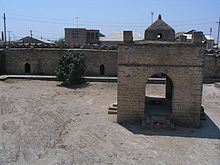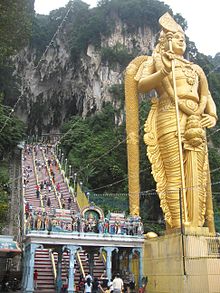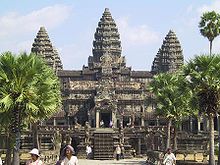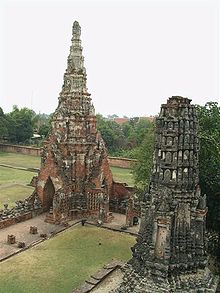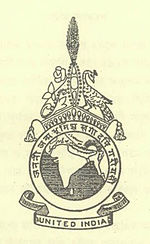- Greater India
-
 Dark orange: The Indian subcontinent. Light orange: Other countries culturally linked to India, notably Burma, Thailand, Cambodia, Laos, Southern Vietnam, Indonesia, Malaysia, Brunei and Singapore. Yellow: Regions with significant cultural Indian influence, notably Afghanistan, Tibet, Yunnan and Philippines.
Dark orange: The Indian subcontinent. Light orange: Other countries culturally linked to India, notably Burma, Thailand, Cambodia, Laos, Southern Vietnam, Indonesia, Malaysia, Brunei and Singapore. Yellow: Regions with significant cultural Indian influence, notably Afghanistan, Tibet, Yunnan and Philippines.
Greater India (also referred as the Indosphere) is a term that refers to the historical spread of the culture of India beyond the Indian subcontinent. This particularly concerns the spread of Hinduism in Southeast Asia, introduced by the Indianized kingdoms of the 5th to 15th centuries, but may also extend to the earlier spread of Buddhism from India to Central Asia and China by the Silk Road during the early centuries of the Common Era. To the west, Greater India overlaps with Greater Persia in the Hindu Kush and Pamir mountains. Historically, the term is also tied to the geographic uncertainties surrounding the "Indies" during the Age of Exploration.
Contents
Evolution of the term
In detail, the notion of Greater India can be discussed in terms of several related meanings:
- In medieval literature and geography: the term "Greater India" (Portuguese: Indyos mayores[3]) was used at least from the mid-15th century.[3] The term, which seems to have been used with variable precision,[4] sometimes meant only the Indian subcontinent;[5] however, at other times, in some accounts of European nautical voyages, "Greater India" (or "India Major") extended from the Malabar Coast (present-day Kerala) to India extra Gangem[6] (lit. "India, beyond the Ganges," but usually the East Indies, i.e. present-day Malay Archipelago) and "India Minor," from Malabar to Sind.[7]
- In late 19th-century geography: The term "Greater India" referred to Hindustan (India proper), the Punjab, the Himalayas and extends eastwards to Indo-China (including Burma), parts of Indonesia (namely, the Sunda Islands, Borneo and Celebes), and even the Philippines."[8]
- In 20th-century history, art history, linguistics, and allied fields: The term "Greater India," now largely out of favor,[9] consists of "lands including Burma, Java, Cambodia, Bali, and the former Champa and Funan polities of present-day Vietnam,"[9] in which pre-Islamic Indian culture left an "imprint in the form of monuments, inscriptions and other traces of the historic ‘Indianising’ process."[9] In some accounts, many Pacific societies and "most of the Buddhist world including Ceylon, Tibet, central Asia, and even Japan were held to fall within this web of Indianising ‘culture colonies’"[9] This particular usage—implying cultural "sphere of influence" of India—was spurred by the formation of The Greater India Society by a group of Bengali men of letters[10] and does not go back to before the 1920s (lasting well into the 1970s in history and later in other fields).
- In geology: The term "Greater India," still current, is used to mean "the Indian sub-continent plus a postulated northern extension,"[11] in plate tectonic models of the India–Asia collision. Although its usage in geology pre-dates plate tectonic theory,[12] the term has seen increased usage since the 1970s.
Indian cultural sphere
The meaning of "Greater India" as an Indian cultural sphere was popularized by a network of Bengali scholars in the 1920s who were all members of the Calcutta-based Greater India Society. The movement's early leaders included the historian R. C. Majumdar (1888–1980); the philologists Suniti Kumar Chatterji (1890–1977) and P.C. Bagchi (1898–1956), the historians Phanindranath Bose and Kalidas Nag (1891–1966).[13]
Some of their formulations were inspired by the then ongoing excavations in Angkor by French archaeologists and by the writings of French Indologist Sylvain Lévi. The scholars of the society postulated a benevolent ancient Indian cultural colonization of Southeast Asia, in stark contrast—in their view—to the colonialism of the early 20th century.[14][15]
“ The ancient Hindus of yore were not simply a spiritual people, always busy with mystical problems and never troubling themselves with the questions of 'this world'... India also has its Napoleons and Charlemagnes, its Bismarcks and Machiavellis. But the real charm of Indian history does not consist in these aspirants after universal power, but in its peaceful and benevolent Imperialism—a unique thing in the history of mankind. The colonizers of India did not go with sword and fire in their hands; they used... the weapons of their superior culture and religion... The Buddhist age has attracted special attention, and the French savants have taken much pains [sic] to investigate the splendid monuments of the Indian cultural empire in the Far East. ” The term was used in historical writing in India well into the 1970s.[16]
“ "Colonial and Cultural Expansion (of Ancient India)", and written by R. C. Majumdar, concluded with: "We may conclude with a broad survey of the Indian colonies in the Far East. For nearly fifteen hundred years, and down to a period when the Hindus had lost their independence in their own home, Hindu kings were ruling over Indo-China and the numerous islands of the Indian Archipelago, from Sumatra to New Guinea. Indian religion, Indian culture, Indian laws and Indian government moulded the lives of the primitive races all over this wide region, and they imbibed a more elevated moral spirit and a higher intellectual taste through the religion, art, and literature of India. In short, the people were lifted to a higher plane of civilization." ” The term "Greater India" as well as the notion of an explicit Hindu colonization of ancient Southeast Asia have been linked to both Indian nationalism[17] and Hindu nationalism,[18] however, many Indian nationalists, like Nehru and Tagore, although receptive to "an idealisation of India as a benign and uncoercive world civiliser and font of global enlightenment,"[19] stayed away from explicit "Greater India" formulations.[20] In addition, some scholars have seen the Hindu/Buddhist acculturation in ancient Southeast Asia as "a single cultural process in which Southeast Asia was the matrix and South Asia the mediatrix."[21] In the field of art history, especially in American writings on the Indian art history, the term survived longer due to the influence of art theorist Ananda Coomaraswamy. Coomaraswamy's view of pan-Indian art history was influenced by the "Calcutta cultural nationalists."[22]
Recently, scholars like Sheldon Pollock have written about this region by using the term "Sanskrit Cosmopolis" and argued for the millennium-long cultural exchanges, without necessarily involving migration of peoples or colonization. Pollock's 2006 book "The Language of the Gods in the World of Men" makes a case for studying this region as comparable with the Latin Europe and argues that the Sanskrit language was the unifying element of this region.
Indianized kingdoms
 The 9th century Shivaistic temple of Prambanan in Central Java near Yogyakarta, the largest Hindu temple in Indonesia.
The 9th century Shivaistic temple of Prambanan in Central Java near Yogyakarta, the largest Hindu temple in Indonesia.
The concept of the Indianized kingdoms, first described by George Coedès, is based upon the Hindu and Buddhist cultural and economic influences in Southeast Asia.[23] Funan, Champa, Langkasuka, Pan Pan, Kutai, Tarumanagara and Kalingga were among the earliest Hindu kingdoms in Southeast Asia established around 1st to 4th century. Despite being culturally akin to Hindu cultures to western historians, these kingdoms were truly indigenous and independent of India. States such as Srivijaya, Majapahit and the Khmer empire developed territories and economies that rivalled those in India itself. Borobudur, for example, is the largest Buddhist monument ever built.[24] Coedès has been criticised for understating the Southeast Asian element of these kingdoms, in an unconscious echo of the European "civilising mission."[25]
More recent scholars tend to emphasize the contribution of Southeast Asian societies and rulers to the formation of these states. In particular, where Coedès saw Indian merchants as the founders of these states, contemporary scholars see Southeast Asian rulers as founding them and then importing Indian ritual specialists as advisers on rajadharma, or the practices of Indian kingship. The modern view is supported by the argument that merchants would not have possessed the ritual knowledge so prominent in these kingdoms.[26]
These Indianized kingdoms developed a close affinity and internalised Indian religious, cultural and economic practices without significant direct input from Indian rulers themselves. While the issue remains controversial, it is thought that Indianization was the work of Indian traders and merchants as opposed to political leaders, although later the travels of Buddhist monks such as Atisha became important. Most Indianized kingdoms combined both Hindu and Buddhist beliefs and practices in a syncretic manner. Kertanagara, the last king of Singhasari, described himself as Sivabuddha, a simultaneous incarnation of the Hindu god and the Buddha.
Southeast Asian rulers enthusiastically adopted elements of raja-dharma (Hindu and Buddhist beliefs, codes and court practices) to legitimate their own rule and constructed cities, such as Angkor, to affirm royal power by reproducing a map of sacred space derived from the Ramayana and Mahabharata. Southeast Asian rulers frequently adopted lengthy Sanskrit titles and founded cities, such as Ayutthaya in Thailand, named after those in the Indian epics.
Cultural and trading relations between the powerful Chola kingdom of South India and the Southeast Asian Hindu kingdoms, led the Bay of Bengal to be called "The Chola Lake" and the Chola attacks on Srivijaya in the tenth century CE are the sole example of military attacks by Indian rulers against Southeast Asia. The Pala dynasty of Bengal, which controlled the heartland of Buddhist India maintained close economic, cultural and religious ties, particularly with Srivijaya.
Cultural commonalities
A defining characteristic of the cultural link between South East Asia and Indian subcontinent is the spread of ancient Indian Vedic/Hindu and Buddhist culture and philosophy into Myanmar, Thailand, Malaya, Laos and Cambodia. Indian scripts are also found in South East Asian islands ranging from Sumatra, Java, Bali, south Sulawesi and most of the Philippines.[27] The impact of Indian culture is visible in the following notable examples:
- Hinduism is practiced by the majority of Bali's population.[28]
- Hindu mythological figure Garuda features in the coats of arms of Indonesia, Thailand and Ulan Bator.
- Hindu temple architecture-style features prominently on several ancient temples in South East Asia including Angkor Wat, which was dedicated to Hindu god Vishnu and features on the flag of Cambodia.
- Wayang shadow puppets and also some classical dance-dramas of Indonesia, Cambodia and Thailand were often took stories from episodes of Ramayana and Mahabharata.
- Older mosques in Indonesia, such as the Great Mosque of Demak and Kudus mosque minaret resemble Majapahit Hindu temples.
- Many Indonesian names have Sanskrit origin (eg. Dewi Sartika, Megawati Sukarnoputri, Susilo Bambang Yudhoyono, Teuku Wisnu).
- Batu Caves in Malaysia is one of the most popular Hindu shrines outside India. It is the focal point of the annual Thaipusam festival in Malaysia and attracts over more than 1.5 million pilgrims, making it one of the largest religious gatherings in history.[29]
- Erawan Shrine, dedicated to Brahma, in Thailand is one of the most popular religious shrines in the country.[30]
- Kaharingan, an indigenous religion followed by Dayak people of Borneo, is categorized as a form of Hinduism in Indonesia.
- Beliefs of some Filipino people, including that of the supreme god Bathala and the concept of Diwata and Karma, are all derived from Hindu-Buddhist concepts.
- Street signs in Yogyakarta, Indonesia, are often written in Indian-derived Kawi script.
- The Sanskrit name of the King of Thailand Bhumibol Adulyadej.[31]
Undivided India
Undivided India, also known natively as Akhand Bharat (Hindustani: अखण्ड भारत (Devanagari) اکھنڈ بھارت (Nastaleeq)) or Akhand Hindustan (Hindustani: अखण्ड हिन्दुस्तान (Devanagari) اکھنڈ ہندوستان (Nastaleeq)), is a currently used official legal term.[32] References to the term Undivided India are found in legal enactments of the Republic of India, including its Citizenship Act 1955, which states that in the context of the Act "undivided India means India as defined in the Government of India Act 1935"[33] according to the historians this act was a bunch of errors. Undivided India refers to the major part of South Asia which comprised India under the British Raj and included the current sovereign states of India, Bangladesh, and Pakistan.
Anushilan Samiti was an armed anti-British organisation in British India[34][35] and the principal secret revolutionary organisation operating in the region of Bengal in the opening years of the 20th century. Its symbol was United India as appears from the logo given here on left hand side. This association, like its offshoot the Jugantar, operated under the guise of suburban fitness club. The members were committed towards the path of armed revolution for independence of India from British rule. Kolkata and, later, Dhaka were the two major strongholds of the association. However, the group succeeded in penetrating rural Bengal and had branches all over Bengal and also other parts of India. Some of its members formed another big organisation called Hindustan Republican Association whose branches had expanded all over India.
There are many other references to the term Undivided India, most also meaning "India" as it existed just before the partition of India into the modern-day republic of India and the Islamic republic of Pakistan. As per June 3 Plan of 1947 brought by the British Government, when all of the efforts to keep India united failed, they chalked out a plan for the transfer of power and the division of the country. The plan was finalized in the Governor's Conference in April 1947, and was then sent to Britain in May 1947 where the British Government approved it.[36] Thus they kept themselves united but divided India at the last moment.
In current times the passports of Indian citizens born before 1947 in areas which are today part of Pakistan or Bangladesh commonly show "Undivided India" as the country of birth. The Government of India and its embassies and consulates abroad issue birth certificates to these citizens of India as having born in the country "Undivided India".
See also
- Sanskritization
- Hinduism in Southeast Asia
- Indies
- Two-Nation Theory
Notes
- ^ Abraham Valentine Williams Jackson (1911), From Constantinople to the home of Omar Khayyam: travels in Transcaucasia and northern Persia for historic and literary research, The Macmillan company, http://books.google.com/books?id=Z4aBAAAAIAAJ, "... they are now wholly substantiated by the other inscriptions ... They are all Indian, with the exception of one written in Persian ... dated in the same year as the Hindu tablet over it ... if actual Gabrs (i.e. Zoroastrians, or Parsis) were among the number of worshipers at the shrine, they must have kept in the background, crowded out by Hindus, because the typical features Hanway mentions are distinctly Indian, not Zoroastrian ... met two Hindu Fakirs who announced themselves as 'on a pilgrimage to this Baku Jawala Ji' ..."
- ^ Richard Delacy, Parvez Dewan (1998), Hindi & Urdu phrasebook, Lonely Planet, ISBN 0864424256, http://books.google.com/books?id=QkJH90HBlekC, "... The Hindu calendar (vikramaditiy) is 57 years ahead of the Christian calendar. Dates in the Hindu calendar are prefixed by the word: samvat संवत ..."
- ^ a b (Azurara 1446)
- ^ (Beazley 1910, p. 708) Quote: "Azurara's hyperbole, indeed, which celebrates the Navigator Prince as joining Orient and Occident by continual voyaging, as transporting to the extremities of the East the creations of Western industry, does not scruple to picture the people of the Greater and the Lesser India welcoming his ships (which never passed beyond Sierra Leone), praising his generosity, and even experiencing his hospitality."
- ^ (Beazley 1910, p. 708) Quote: "Among all the confusion of the various Indies in Mediaeval nomenclature, "Greater India" can usually be recognized as restricted to the "India proper" of the modern world."
- ^ (Wheatley 1982, p. 13) Quote: "From the time when Southeast Asia first rose above their horizon, Europeans—the infinitesimal number of them who cared about such matters, that is—tended to treat that vague and insubstantial region beneath the sunrise as simply a more distant part of India. This practice went back at least to Claudius Ptolemy or, possibly, one of his redactors, who subsumed a good part of the region under the rubric "Trans-Gangetic India." Subsequently the whole area came to be identified with one of the "Three Indies," though whether India Major or Minor, Greater or Lesser, Superior or Inferior, seems often to have been a personal preference of the author concerned. When Europeans began to penetrate into Southeast Asia in earnest, they continued this tradition, attaching to various of the constituent territories such labels as Further India or Hinterindien, the East Indies, the Indian Archipelago, Insulinde, and, in acknowledgment of the presence of a competing culture, Indochina."
- ^ (Caverhill 1767)
- ^ "Review: New Maps," (1912) Bulletin of the American Geographical Society 44(3): 235-240.
- ^ a b c d (Bayley 2004, p. 713)
- ^ (Handy 1930, p. 364) Quote: "An equally significant movement is one that brought about among the Indian intelligentsia of Calcutta a few years ago the formation of what is known as the "Greater India Society," whose membership is open "to all serious students of the Indian cultural expansion and to all sympathizers of such studies and activities." Though still in its infancy, this organization has already a large membership, due perhaps as much as anything else to the enthusiasm of its Secretary and Convener, Dr. Kalidas Nag, whose scholarly affiliations with the Orientalists in the University of Paris and studies in Indo-China, Insulindia and beyond, have equipped him in an unusual way for the work he has chosen-namely, stimulating interest in and spreading knowledge of Greater Indian culture of the past, present and future. The Society's President is Professor Jadunath Sarkar, Vice-Chancellor of Calcutta University, and its Council is made up largely of professors on the faculty of the University and members of the staff of the Calcutta Museum, as well as of Indian authors, journalists, and so on. Its activities, besides meetings, have included illustrated lecture series at the various universities throughout India by Dr. Nag, the assembling of a research library and the publication of monographs, of which four very excellent examples have already been printed: 1)Greater India, by Kalidas Nag, M.A., D.Litt(Paris), 2) India and China, by Prabodh Chandra Bagchi, M.A., D.Litt., 3) Indian Culture in Java and Sumatra, by Bijan Raj Chatterjee, D.Litt. (Punjab), Ph.D (London), and 4) India and Central Asia, by Niranjan Prasad Chakravarti, M.A., Ph.D.(cantab.)."
- ^ (Ali & Aitchison 2005, p. 170)
- ^ Argand, E., 1924. La tectonique de l' Asie. Proc. 13th Int. Geol. Cong. 7 (1924), 171–372.
- ^ (Bayley 2005, p. 710)
- ^ (Bayley 2005, p. 712)
- ^ Review by 'SKV' of The Hindu Colony of Cambodia by Phanindranath Bose [Adyar, Madras: Theosophical Publishing House 1927] in The Vedic Magazine and Gurukula Samachar 26: 1927, pp. 620–1.
- ^ (Majumdar 1960, pp. 222–223)
- ^ (Keenleyside 1982, pp. 213–214) Quote: "Starting in the 1920s under the leadership of Kalidas Nag-and continuing even after independence-a number of Indian scholars wrote extensively and rapturously about the ancient Hindu cultural expansion into and colonization of South and Southeast Asia. They called this vast region "Greater India"–a dubious appellation for a region which to a limited degree, but with little permanence, had been influenced by Indian religion, art, architecture, literature and administrative customs. As a consequence of this renewed and extensive interest in Greater India, many Indians came to believe that the entire South and Southeast Asian region formed the cultural progeny of India; now that the sub-continent was reawakening, they felt, India would once again assert its non-political ascendancy over the area.... While the idea of reviving the ancient Greater India was never officially endorsed by the Indian National Congress, it enjoyed considerable popularity in nationalist Indian circles. Indeed, Congress leaders made occasional references to Greater India while the organization's abiding interest in the problems of overseas Indians lent indirect support to the Indian hope of restoring the alleged cultural and spiritual unity of South and Southeast Asia."
- ^ (Thapar 1968, pp. 326–330) Quote: "At another level, it was believed that the dynamics of many Asian cultures, particularly those of Southeast Asia, arose from Hindu culture, and the theory of Greater India derived sustenance from Pan-Hinduism. A curious pride was taken in the supposed imperialist past of India, as expressed in sentiments such as these: "The art of Java and Kambuja was no doubt derived from India and fostered by the Indian rulers of these colonies." (Majumdar, R. C. et al. (1950), An Advanced History of India, London: Macmillan, p. 221) This form of historical interpretation, which can perhaps best be described as being inspired by Hindu nationalism, remains an influential school of thinking in present historical writings."
- ^ (Bayley 2004, pp. 735–736) Quote:"The Greater India visions which Calcutta thinkers derived from French and other sources are still known to educated anglophone Indians, especially but not exclusively Bengalis from the generation brought up in the traditions of post-Independence Nehruvian secular nationalism. One key source of this knowledge is a warm tribute paid to Sylvain Lévi and his ideas of an expansive, civilising India by Jawaharlal Nehru himself, in his celebrated book, The Discovery of India, which was written during one of Nehru’s periods of imprisonment by the British authorities, first published in 1946, and reprinted many times since. ... The ideas of both Lévi and the Greater India scholars were known to Nehru through his close intellectual links with Tagore. Thus Lévi’s notion of ancient Indian voyagers leaving their invisible ‘imprints’ throughout east and southeast Asia was for Nehru a recapitulation of Tagore’s vision of nationhood, that is an idealisation of India as a benign and uncoercive world civiliser and font of global enlightenment. This was clearly a perspective which defined the Greater India phenomenon as a process of religious and spiritual tutelage, but it was not a Hindu supremacist idea of India’s mission to the lands of the trans-gangetic ‘Sarvabhumi’ or ‘Bharat Varsha’."
- ^ (Narasimhaiah 1986) Quote: "To him (Nehru), the so-called practical approach meant, in practice, shameless expediency, and so he would say, "the sooner we are not practical, the better". He rebuked a Member of Indian Parliament who sought to revive the concept of Greater India by saying that ‘the honorable Member lived in the days of Bismarck; Bismarck is dead, and his politics more dead!' He would consistently plead for an idealistic approach and such power as the language wields is the creation of idealism—politics’ arch enemy—which, however, liberates the leader of a national movement from narrow nationalism, thus igniting in the process a dead fact of history, in the sneer, "For him the Bastille has not fallen!" Though Nehru was not to the language born, his utterances show a remarkable capacity for introspection and sense of moral responsibility in commenting on political processes."
- ^ (Wheatley 1982, pp. 27–28) Quote: "The tide of revisionism that is currently sweeping through Southeast Asian historiography has in effect taken us back almost to the point where we have to consider reevaluating almost every text bearing on the protohistoric period and many from later times. Although this may seem a daunting proposition, it is nonetheless supremely worth attempting, for the process by which the peoples of western Southeast Asia came to think of themselves as part of Bharatavarsa (even though they had no conception of "India" as we know it) represents one of the most impressive instances of large-scale acculturation in the history of the world. Sylvain Levi was perhaps overenthusiastic when he claimed that India produced her definitive masterpieces—he was thinking of Angkor and the Borobudur—through the efforts of foreigners or on foreign soil. Those masterpieces were not strictly Indian achievements: rather were they the outcome of a Eutychian fusion of natures so melded together as to constitute a single cultural process in which Southeast Asia was the matrix and South Asia the mediatrix."
- ^ (Guha-Thakurta 1992, pp. 159–167)
- ^ National Library of Australia. Asia's French Connection : George Coedes and the Coedes Collection
- ^ Theories of Indianization Exemplified by Selected Case Studies from Indonesia (Insular Southeast Asia), by Dr. Helmut Lukas
- ^ Charles F. Keyes, The golden peninsula : culture and adaptation in mainland Southeast Asia, page 106, SHAPS Library of Asian Studies, University of Hawai'i Press, 1995, ISBN 0-8248-1696-X
- ^ Paul Wheatley, Satyānrta in Suvarṇadvīpa: From Reciprocity to Redistribution in Ancient Southeast Asia, (Ancient Civilization and Trade ed. by Jeremy Sabloff and C. C. Lamberg-Karlovsky), pages 227-83 Albuquerque: University of New Mexicon Press, 1975
- ^ Martin Haspelmath, The World Atlas of Language Structures, page 569, Oxford University Press, 2005, ISBN 0-19-925591-1
- ^ Balinese Religion
- ^ lonelyplanet.tv - Batu Caves Inside and Out,Malaysia
- ^ Buddhist Channel | Buddhism News, Headlines | Thailand | Phra Prom returns to Erawan Shrine
- ^ SHARMA, SUDHINDRA. "King Bhumibol and King Janak". nepalitimes.com. HIMALMEDIA PRIVATE LIMITED. http://www.nepalitimes.com/issue/2003/08/15/Culture/3595. Retrieved 2011-07-13.
- ^ Kanaiyalal Maneklal Munshi (1967). Indian Constitutional Documents, Volume 1. Bharatiya Vidya Bhavan. http://books.google.com/books?id=6QMzAAAAIAAJ&q=akhand+hindustan&dq=akhand+hindustan&hl=en&ei=t6SkToqbE4n40gG98PWyBA&sa=X&oi=book_result&ct=result&resnum=2&ved=0CDIQ6AEwAQ. "AKHAND HINDUSTAN CAMPAIGN I initiated the Akhand Hindustan (United India) Front."
- ^ Dr.'Krant'M.L.Verma Swadhinta Sangram Ke Krantikari sahitya Ka Itihas (Vol-3) p.744
- ^ Goldstone, Jack A. (2003). States, parties, and social movements. Cambridge University Press. pp. 183. ISBN 9780521016995.
- ^ Overstreet, Gene D.; Marshall Windmiller (1959). Communism in India. University of California Press. pp. 44. http://books.google.com/books?id=PAFBW743Bi4C&pg=PA44&dq=terrorist+%22anushilan+samiti%22&lr=&num=100&as_brr=3&ei=U-hTS8SbHp_4lAS2-6iaDQ&cd=26#v=onepage&q=terrorist%20%22anushilan%20samiti%22&f=false.
- ^ http://www.storyofpakistan.com/articletext.asp?artid=A049
References
- Ali, Jason R.; Aitchison, Jonathan C. (2005), "Greater India", Earth-Science Reviews 72 (3-4): 169–188, doi:10.1016/j.earscirev.2005.07.005.
- Azurara, Gomes Eannes de (1446), Chronica do Discobrimento e Conquista de Guiné (eds. Carreira and Pantarem, 1841), Paris.
- Bayley, Susan (2004), "Imagining ‘Greater India’: French and Indian Visions of Colonialism in the Indic Mode", Modern Asian Studies 38 (3): 703–744, doi:10.1017/S0026749X04001246.
- Beazley, Raymond (1910), "Prince Henry of Portugal and the Progress of Exploration", The Geographical Journal 36 (6): 703–716, http://links.jstor.org/sici?sici=0016-7398%28191012%2936%3A6%3C703%3APHOPAT%3E2.0.CO%3B2-J.
- Caverhill, John (1767), "Some Attempts to Ascertain the Utmost Extent of the Knowledge of the Ancients in the East Indies", Philosophical Transactions 57: 155–178
- Guha-Thakurta, Tapati (1992), The making of a new ‘Indian’ art. Artists, aesthetics and nationalism in Bengal, c. 1850–1920., Cambridge, UK: Cambridge University Press.
- Handy, E. S. Craighill (1930), "The Renaissance of East Indian Culture: Its Significance for the Pacific and the World", Pacific Affairs 3 (4): 362–369, http://links.jstor.org/sici?sici=0030-851X%28193004%293%3A4%3C362%3ATROEIC%3E2.0.CO%3B2-L.
- Keenleyside, T. A. (1982), "Nationalist Indian Attitudes Towards Asia: A Troublesome Legacy for Post-Independence Indian Foreign Policy", Pacific Affairs 55 (2): 210–230, http://links.jstor.org/sici?sici=0030-851X%28198222%2955%3A2%3C210%3ANIATAA%3E2.0.CO%3B2-3.
- Majumdar, R. C., H. C. Raychaudhuri, and Kalikinkar Datta (1960), An Advanced History of India, London: Macmillan and Co., 1122 pages.
- Narasimhaiah, C. D. (1986), "The cross-cultural dimensions of English in religion, politics and literature", World Englishes 5 (2-3): 221–230, doi:10.1111/j.1467-971X.1986.tb00728.x.
- Thapar, Romila (1968), "Interpretations of Ancient Indian History", History and Theory 7 (3): 318–335, http://links.jstor.org/sici?sici=0018-2656%281968%297%3A3%3C318%3AIOAIH%3E2.0.CO%3B2-%23.
- Wheatley, Paul (1982), "Presidential Address: India Beyond the Ganges--Desultory Reflections on the Origins of Civilization in Southeast Asia", The Journal of Asian Studies 42 (1): 13–28, http://links.jstor.org/sici?sici=0021-9118%28198211%2942%3A1%3C13%3APAIBTG%3E2.0.CO%3B2-Z.
- Dr.'Krant'M.L.Verma Swadhinta Sangram Ke Krantikari Sahitya Ka Itihas (3 Volumes) 2006 New Delhi Praveen Prakashan ISBN 8177831224 (set).
Further reading
- Language variation: Papers on variation and change in the Sinosphere and in the Indosphere in honor of James A. Matisoff, David Bradley, Randy J. LaPolla and Boyd Michailovsky eds., pp. 113–144. Canberra: Pacific Linguistics.
- Ankerl, Guy (2000). Global communication without universal civilization. INU societal research. Vol.1: Coexisting contemporary civilizations : Arabo-Muslim, Bharati, Chinese, and Western. Geneva: INU Press. ISBN 2-88155-004-5.
External links
- Greater India - Suvarnabhumi
- Papers on variation and change in the Sinosphere and in the Indosphere in honour of James A. Matisoff
- Language diversity: Sinosphere vs. Indosphere
- Himalayan Languages Project
- Rethinking Tibeto-Burman -- Lessons from Indosphere
- Areal linguistics and Mainland Southeast Asia
- THEORIES OF INDIANIZATION Exemplified by Selected Case Studies from Indonesia (Insular Southeast Asia), by Dr. Helmut Lukas
Irredentist movements in the world Africa Asia The Balkans The Caucasus Rest of Europe Middle East South America Argentina
Categories:- Irredentism
- Cultural spheres of influence
- Country classifications
- Foreign relations of India
- Geography of India
- South Asian culture
- Southeast Asian culture
Wikimedia Foundation. 2010.

